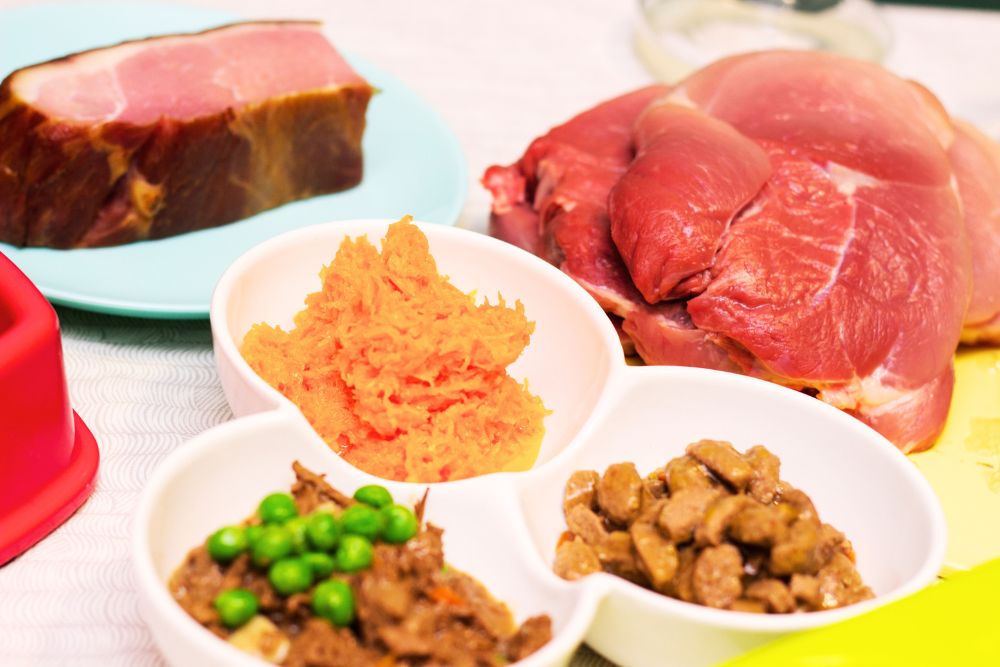From the doggie chef’s kitchen to your pup’s wagging tail, we’ve fetched the most pawsome and delicious homemade dog food recipes just for you. Say goodbye to boring kibble and unleash the flavor-packed adventure that will have your furry best friend drooling with delight.
Not all dogs have the same needs. Some can eat anything and everything; others have sensitive stomachs and struggle with food allergies. No matter their needs, we all want to ensure they eat healthy and nutritious meals that will optimize their health.
If your pup has a sensitive stomach, food allergies, weight management issues, or deserves the best possible care, switching to an all-natural diet is key.
Store-bought natural dog food can be expensive, and you don’t always know if they provide your dog with what they need. Homemade dog food is an easy and affordable way to tailor your dog’s diet to optimize its health. All it requires is a little time and effort on your part.
Whether your canine companion craves a culinary masterpiece, these four easy-to-make recipes will make mealtime a tail-wagging extravaganza! Get ready to tantalize those taste buds and embark on a culinary journey that will have your pooch begging for seconds. Let’s dig into the barking good world of homemade doggie delights!
Discover these four homemade dog food recipe types:
Homemade Dog Food Is:
You can prepare well-balanced and nutritious meals for your dog at home using store-bought ingredients. You can prepare them daily or in advance (meal-prep style) and tailor the components to meet your dog’s needs.
A focus on the quality of dog food is trending too. According to a survey of pet owners in the U.S., more than half of the respondents claim they consider the health and nutrition the food will provide their pet, and searches for low-calorie dog food increased by 110%, searches for organic pet food increased by 35%, and almost one-fifth of owners stated that they cooked for their pet.
A Few Recommendations:
- Consult your veterinarian before switching to homemade dog food.
- You must ensure the meals you prepare for your pup are well-balanced and include the proper nutrients.
- The beauty of homemade dog food is that you can customize it to meet their unique needs. You should adjust their meals depending on age, weight, activity level, breed, health concerns, and personal preferences.
- Homemade dog food can be made in advance. It will last 3-4 days in the refrigerator or up to 6 months in the freezer.
All Well-Balanced and Nutritious Dog Food Needs to Have the Following:
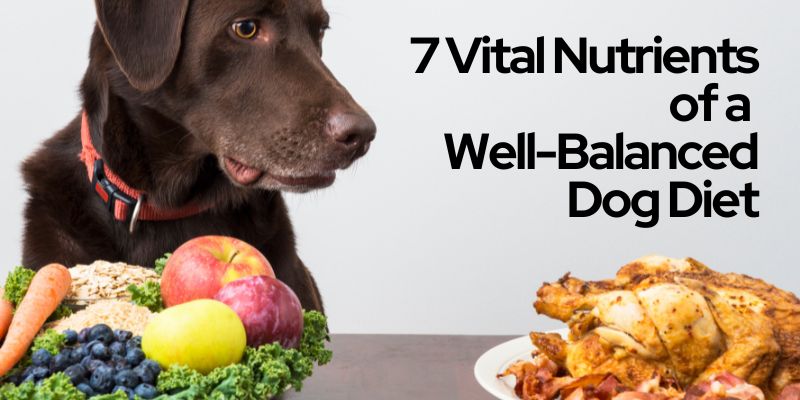
Dogs rely on their diet to provide the vital nutrients they need to stay healthy. When planning your dog’s homemade meal plan, make sure you include all of the following:
1 – Protein (8-18%)
According to ACVN, dogs need to have protein. It is vital to the creation of glucose which transforms into energy. The AAFCO recommends that a minimum of 8%-10% for adult dogs and 18% for growing dogs’ daily calories come from high-quality protein sources.
Example Sources: Boneless, skinless, fatless chicken, turkey, beef, or lamb. Limited quantities of pork and occasionally salmon or other fish like whitefish, herring, walleye, flounder, or arctic char.
While less common than the protein sources mentioned above, a few of our team members prefer to include some of these alternative proteins in their homemade dog food: bison, rabbit, and venison.
2 – Fats & Fatty Acids aka Fat (minimum of 5 – 8%)
Your dog relies on their food to provide fatty acids the body doesn’t manufacture. Fatty acids support the function and structure of cells, keep skin and coat healthy, and enhance food taste.
Example Sources: Plant-based oils like corn, soybean, canola, and flaxseed. You can also use fish oil.
A few dog owners on the Dog Life Mag team add a couple pumps of wild Alaskan salmon oil to their dog’s homemade dog food recipe to meet their dog’s fat and fatty acids daily diet requirements.
3 – Carbohydrates (at least 20% and up to 50%)
Dogs need carbohydrates for energy. Carbohydrates can come from a variety of sources such as white rice, sweet potato, barley, peas, or corn.
Example Sources: Rice, pasta, sweet potato, peas, oatmeal, and quinoa.
4 – Fiber (2.5-4.5%)
Fiber is a type of carbohydrate that supports gastrointestinal system function and prevents them from becoming overweight. It is found mainly in vegetables and select grains. It’s recommended that 2.5% – 4.5% of your dog’s carbohydrate intake be fiber.
Example Sources: Carrots, pumpkins, apples, dark leafy greens, brown rice, and flaxseed.
5 – Vitamins (small amounts)
Vitamin deficiencies can cause various health problems but can also be dangerous in large quantities. Feel free to include them sparingly and in variation.
- Vitamin A: Carrots and pumpkin
- Vitamin B: Liver, green vegetables, whole grains
- Vitamin C: Fruits, vegetables, and organ meat
- Vitamin D: Liver, fish, beef
- Vitamin E: Leafy green vegetables, liver, bran, plant oils
- Vitamin K: Fish, leafy green vegetables
- Choline: Liver, fish, meats, egg yolks
6 – Minerals (small amounts)
Twelve essential minerals need to be in your dog’s diet.
- Calcium and phosphorus for strong bones and teeth. Example sources: tofu, green beans, broccoli, and cauliflower for calcium. Meat and eggs for phosphorus.
- Magnesium, potassium, sodium, and chloride for nerve impulse transmission, muscle contraction, and cell signaling. Example sources: fruits, vegetables, and whole grains.
- Sulfur is good for healthy skin, coat, and nails. Example sources: meat, fish, and molasses.
- Iron is necessary for supporting red blood cells and the immune system. Example sources: red meats and poultry.
- Iodine supports a healthy thyroid. Example sources: dairy, kelp, and seafood.
- Zinc supports the immune system and healthy skin/coat. Example sources: eggs, lamb, liver, and brewer’s yeast.
- Selenium is used to boost the immune system. Example sources: meat, vegetables, seafood, and brown rice.
- Copper supports healthy bone growth. Example sources: whole grains, seeds, and seafood.
7 – Water
While you might not have thought about including water as part of your homemade dog food recipe, it’s one of the major nutrient groups of a well-balanced dog diet, and other than providing your dog with fresh water daily in their water bowl, you can add it to their food as well!
Water aids in digestion, helping dogs break down the food they ingest, aiding in nutrient absorption, important enzyme secretion, and overall cleansing and detoxification.
In our experience, other than using water when cooking your dog’s homemade dog food, after preparing homemade dog food in large batches and storing in airtight containers in the refrigerator, you can mix in a couple tablespoons of fresh water to your dog’s daily portion of dog food to rehydrate it a bit (especially if you plan to warm it up in the microwave for 30 seconds before serving up).
If you are concerned that your dog isn’t receiving all the nutrients they need through their food, you can support their diet with supplements. Also, always speak with your vet about meeting your dog’s dietary and nutritional needs.
The 4 Types of Homemade Dog Food
As you switch to homemade dog food, consider which of the four standard diet plans will work best for your dog and lifestyle. We’ve broken them down and found popular, easy-to-make recipes for each homemade dog food option.
The cost of switching to homemade dog food will vary depending on the ingredients you choose and where you shop. You are buying human-quality ingredients, so use that to indicate the cost.
Raw Dog Food
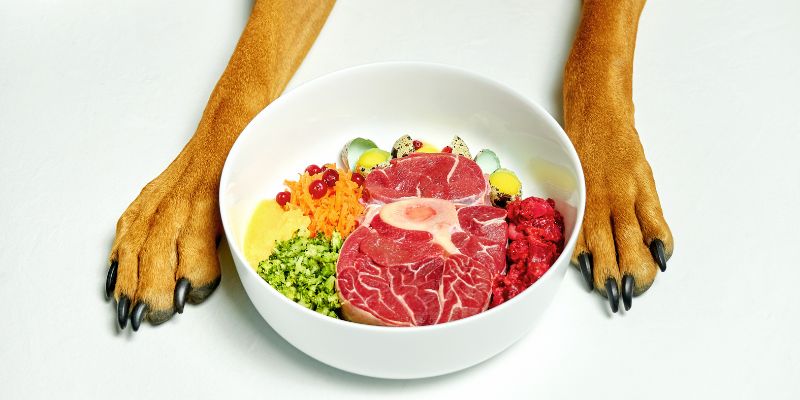
Raw dog food is what it sounds like. A diet consisting of only raw food such as organ meat, whole or ground bone, muscle meat, raw eggs, and dog-safe fruits and vegetables. Advocates for raw dog food claim that it provides their dogs with shiner coats, healthier skin, improved dental health, increased energy, and smaller stool.
However, some vets warn against raw diets because they require excellent care during preparation. It can be risky for dogs with pancreatitis, cancer, or other diseases requiring cooked food. To ensure your dog’s safety, you’ll want to be careful about where you source your ingredients and how you store them.
Raw Dog Food Recipe
This recipe produces 11 lbs. of food and is suitable for dogs at all stages of life.
Ingredients
- 5 pounds 93% lean ground turkey
- 2 pounds chicken heart (grind or chop into small cubes)
- 1 pound beef liver (grind or chop into small cubes)
- 6 pasture-raised eggs without shells
- 8 ounces kale
- 8 ounces broccoli
- 8 ounces dandelion greens
- 12 ounces blueberries or mixed berries (blueberries, raspberries, blackberries, and cranberries)
- 6 tbsp bone meal
- 3 tbsp ground pumpkin seed powder
- 2 tsp Himalayan salt
- 1/4 tsp kelp
Directions
- Puree the eggs, kale, broccoli, dandelion greens, berries, bone meal, pumpkin seed powder, salt, and kelp.
- Then mix the puree with the ground turkey, liver, and heart and portion into freezer-safe containers.
Whole Dog Food

Whole dog food uses only fresh, unprocessed ingredients. The key protein source is meat due to its taurine content. All whole dog food is cooked gently and frozen without preservatives or additives. The lack of preservatives or additives ensures your pup receives all the vital nutrients. You could switch up this recipe and use fresh cooked salmon in place of ground turkey for a homemade salmon dog food recipe that uses whole foods as well!
It can be difficult or expensive to find unprocessed ingredients. However, if you get creative, you might find that it’s a pretty versatile diet.
Whole Dog Food Recipe
This recipe produces a single serving for a 20lb dog.
Ingredients
- 8 ounces ground turkey thigh (boneless)
- 2 tbsp ground organic turkey organ meat (liver, gizzards, hearts)
- ¼ cup finely grated organic veggies
- 1 tsp ground raw sunflower seeds
- 1/2 tsp organic coconut oil
- ½ tsp salmon oil
- 500 mg Calcium Citrate (essential)
Directions
- Blanch veggies, then place in a food processor and pulse until finely grated.
- Gently cook the meat at a low temperature and remove it from the heat when most of it has turned white, but some remains pinkish.
- Mix all ingredients and allow them to cool before serving them.
Grain-free Dog Food
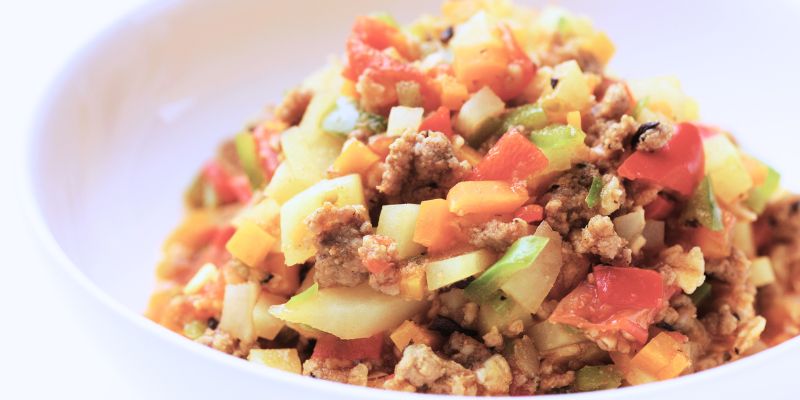
If your dog is overweight or suffers from itchy skin, red patches, or hair loss due to grain allergies, consider switching to a grain-free diet.
A grain-free diet is challenging to get right. Healthy grains provide your dog’s nutrients to maintain a healthy heart. If you want to prepare grain-free dog food for your pup, make the extra effort to ensure it is well-balanced and check with your vet first.
Grain-free Dog Food Recipe
This recipe produces 16 oz of food.
Ingredients
- 1 lb. lean ground turkey
- 1 oz chicken liver
- 4 oz chicken gizzards
- 4 oz sardines
- 2 oz chopped green beans
- 2 oz chopped broccoli
- 2 oz blueberries
- 1 tbsp ground flaxseed
- 1 tbsp chia seeds
- 2 tbsp fresh chopped parsley
- 2 oz chopped apples
- 2 oz shiitake mushrooms
- 1 tablespoon coconut oil
Directions
- Use the coconut oil and cook the ground turkey, chicken liver, and chicken gizzards over medium heat until browned and cooked.
- Add the vegetables, blueberries, parsley, apple, chia seeds, ground flaxseed, and mushrooms.
- Cover and allow to simmer for 10 minutes or until vegetables are tender.
- Wait for it to cool before serving.
Natural Dog Food
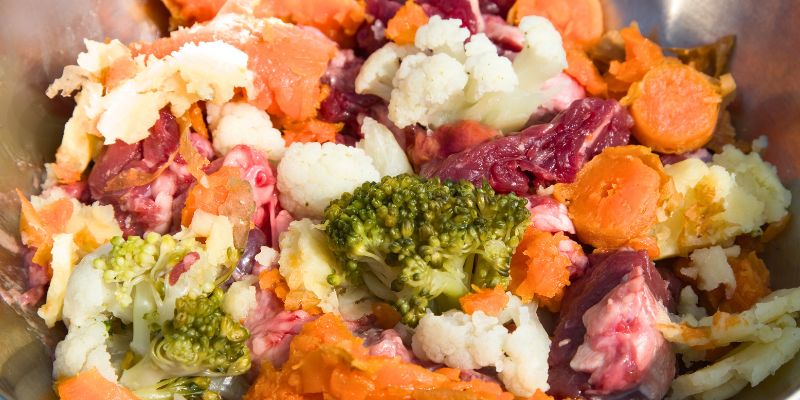
Natural dog food refers to dog food that only consists of ingredients found in nature. Like whole dog food, natural dog food contains no preservatives or additives. It also has no synthesized vitamins or minerals, artificial flavoring, or coloring.
It can be challenging to find ingredients that meet natural food requirements, and when you do, they tend to be more expensive than processed food. However, there are countless recipe options and ingredient variations to choose from.
Natural Dog Food Recipe
This recipe produces 32 oz of food and contains vitamin D, calcium, iron, and potassium.
Ingredients
- 1 pound of beef stew meat
- 1 small, sweet potato
- 1/2 cup of carrots, diced
- 1/2 cup of green beans, diced
- 1/2 cup of flour
- 1/2 cup of water
- 1 tablespoon of vegetable oil
Directions
- Pre-cook the sweet potato in the microwave for about 5-8 minutes or until firm and tender. Allow to cool, then dice into small pieces.
- Slice the beef into small, bite-size chunks and cook with a tablespoon of vegetable oil over medium heat for 10-15 minutes.
- Remove them from the pan and set aside. Heat the drippings over medium-low heat, then slowly add flour and water to the drippings while whisking to create a gravy.
- Add the meat, sweet potatoes, carrots, and green beans into the gravy and stir to coat.
- Cook for about 10 minutes or until the carrots are tender.
- Cool, and then portion and serve.
Alternatives to Homemade Dog Food
Not everyone can afford the time needed to prepare nutritious, well-balanced meals for their dog properly. There are a few options for those who don’t have time to plan and prepare weekly meals for their pup.
1 – Pet Plate
If you like serving your dog all-natural, freshly prepared meals customized to your dog’s needs, then you should try Pet Plate. This subscription service provides high-quality, wholesome dog food correctly formulated for your dog. They offer you affordable natural, whole, or grain-free food for your pup.
2 – Wild Earth
Now, if you want a plant-based option for your kibble loving dog, check out Wild Earth. This plant-based dog kibble is scientifically formulated to optimize your dog’s health. It features only clean and sustainable yeast and plant-based ingredients. It can be expensive, but it’s worth the high price tag for most users.
The Upside of Homemade Dog Food
Every dog is different and thus has other dietary needs depending on their breed, lifestyle, and health concerns. Whether they are picky eaters or have sensitive stomachs, making your dog’s food at home allows you to customize their meals while ensuring they receive the best possible nutrients.
If you want to slowly introduce homemade dog food to your pup, try out our dog food topper recipe! A dog food topper is an optional wet or dry mixture of dog-safe ingredients sprinkled on top of your dog’s regular food to enhance flavor.
With time and research, you can easily prepare nutritious and delicious meals at home for your fur babies!


